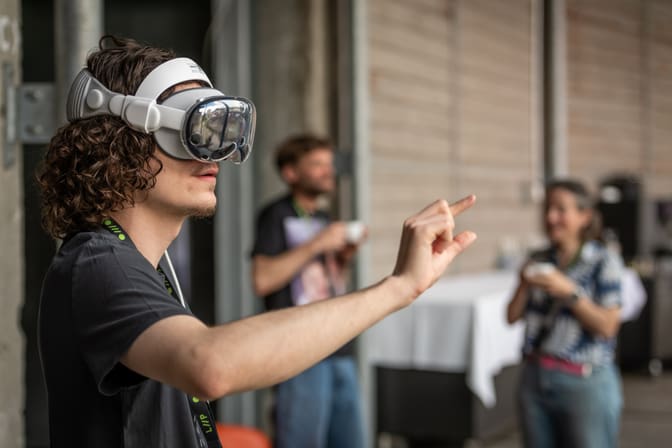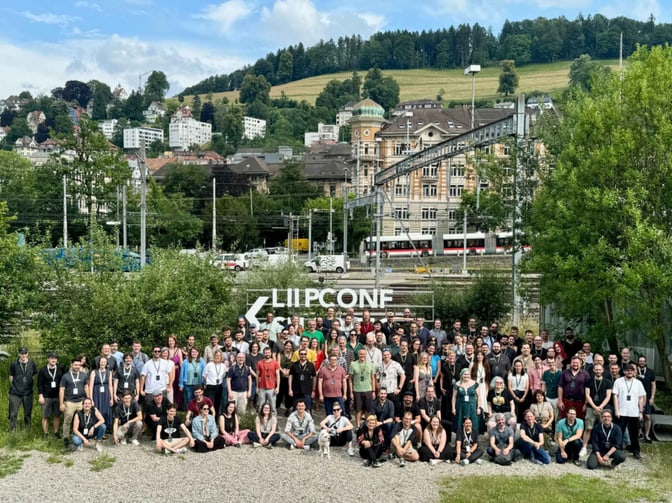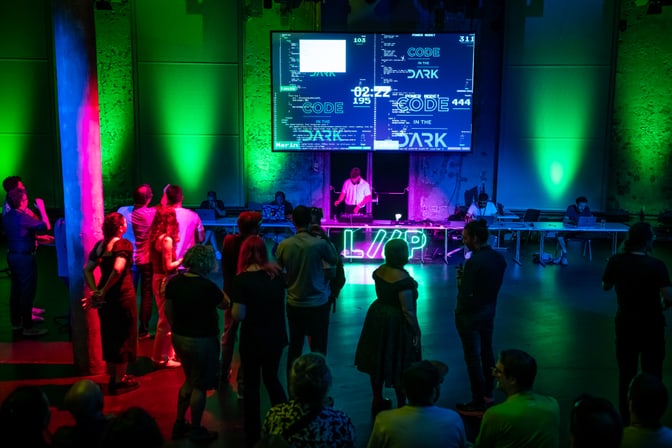Every year, most Liipers come to LiipConf. This year, it was St Gallen’s turn to host this special day, in the Lokremise, a culture centre set up in an old train repair infrastructure. The event consisted of over 30 talks and workshops, mostly held by colleagues, on tech and non-tech topics.
The organising team and I were thrilled to host more than 150 Liipers for the occasion. Some Liipers even decided to spend the night before with us in St. Gallen for dinner and a little karaoke session.
This year’s topic was “Shaping tomorrow”, but it could have been tomorrows with an s, as we listened, discussed and brainstormed on different facets of what the future will bring, and what we can bring to the future.
Tools of tomorrow
Unsurprisingly, AI was (again) a hot topic. We welcomed Dr Stephan Siegrist, founder of the W.I.R.E. think tank, who analysed new developments, trends, and technologies at the interface between science and practice. AI is not new, but its recent democratisation through generative AI (actually more data- and algorithm-based systems than artificial intelligence) has been the main disruption. With new promises, opportunities and fears it brought. In the current AI innovation cycle, the goal is to move fast, even if we break things along the way. There is also a theatre or innovation washing, where instead of focusing on solving real-world needs, there is a show for the public and investors.
Ultimately, you need to think about the SDG consequences of your AI use, how you use data, and how you can be creative. This was a welcome outsider perspective, aligned with what we are trying to achieve. During a workshop, Xenia and Petra also focused on the impact of AI on UX-related work during an interesting workshop with our specialists in UX Strategy, UX / UI Design, Content Strategy, and UX Writing.
We also drew inspiration from up-and-coming digital solutions, AI or not, that are already shaping the future. During a workshop organised by David, each participant presented one tool. Among the ones shared were discussion platform logora, digital solution for cooperative grocery stores epicerio, distraction reducer and focus enabler brain.fm, Proton web tools with privacy as default, ethical fashion brand rater Good on you and food and cosmetic products' scanner Yuka. It was great to see Liipers discover new tools and assess others, bringing clarity to the jungle of emerging digital solutions. We will organise events on digital solutions for a sustainable future in the following months.
Spatial computing has again been a hot topic with the recent introduction of Apple Vision Pro. Some of our Liipers were lucky to try them a few months ago, joining a hackathon to identify potential uses of these AR/VR glasses. We also tested them during the day, true to our practice over theory principle. It was fun, but just like AI, our goal is to go beyond the hype and find the use cases where the technology can be the best to help solve actual users' issues. Thomas, who co-organised the tests, will write a few blogposts on the technology, its promises and limits.

Tomorrow’s work
We all know about IT architecture, but thanks to Joël, we found out we can also find inspiration from actual architecture work for a more effective and cost-efficient approach to Web Design. Like architects, we can identify, share, and reuse exceptional design elements without compromising our visual excellence and focus on the users’ needs in a cost-efficient approach.
Guidelines are nothing new and sometimes taken for granted, yet they are even more important for our work in the future. Diana highlighted the example of design and usability checks. In a client project, the website or app must align with the client’s brand guidelines. Nevertheless, it is crucial to ensure brand colours for digital usage are compatible with usability standards. Sometimes, we can overlook this aspect in the beginning and end up with major changes to be applied before the go-live, with huge financial consequences. Our duty as experts is to check this upfront; this is part of our expertise and can save our clients money.
We are also working on sustainable web development guidelines, inspired by the W3C framework. But more than long guidelines, we want to provide a checklist tool that is more efficient for our developers and designers colleagues working on a client project. Michelle came all the way from Sweden to give a more developer-focused presentation on the W3C guidelines and what they mean technically. With end-user expectations increasing and competitors upskilling in usability and sustainability, these guidelines and checklist tools will even be more crucial tomorrow.
Sustainable tomorrow
Given the environmental crises we face, we have to think now more than ever about the impact of the digital world we are shaping. In other words, as Gerhard pointed out, the time has come to give capitalism a much-needed software update. As a private company, we are, of course, part of the capitalist environment, but that doesn’t mean that we have no impact on how capitalism works. There are 3 upgrades for the economy.
First, collaboration 2.0, with open knowledge, open source, open data, co-creation rather than competition, and open manufacturing are key. Open Source and Data are not new to us, but are to be even more relevant tomorrow, as is collaboration 2.0 to help us develop better solutions. Second, circular economy, with short distances and efficiency, stuff that can be repaired and/or recycled.
The third upgrade is less talked about: accounting. It is used to reflect a company's financial health, yet doesn't provide the full picture of the company and its impact on the people and the planet. This has to be considered because what gets measured can be improved. We are actually doing with the Progress Metric we developed two years ago to measure the impact of the digital tools we develop for our clients.
In this changing world, becoming experts in key topics such as energy, mobility, or biodiversity is also crucial. In these fields, like others we work on, clients expect for us to bring some understanding and knowledge of their work environment to the table, on top of our expertise in dev, UX or agility. Thanks to our outsider perspective, it is about understanding the context and challenges while bringing innovative solutions, thanks to our outsider perspective. This is what we were able to achieve with a project like Powertracker in the energy sector. To do that in other fields, we are initiating guilds of experts on key topics, with specific training and mentoring to onboard colleagues.
Some fun at night before diving into tomorrow
I wish I had the gift of ubiquity to attend all the slots happening at the same time because I couldn’t participate in some interesting sessions on diversity as a strength, powercoders, Sveltekit, Web Sockets, business intelligence, MS Azure, agility, mentoring juniors, strategic storytelling and sociocracy at Alternative Bank.. Before the well-deserved apero and vegan dinner, it was time for the annual group picture.

To close this LiipConf 2024, we had our first-ever “Code in the Dark” session. It is a front-end contest originating from Tictail, where you implement a website design using a screenshot without previews or measuring tools. The screen was projected, and the audience could check the work in progress and spot any mistakes. To add to the fun, there was a party with a DJ, of course, to push the coding limits of the participants. Congrats to all the participants, and a special mention goes to Ben for winning this first edition.

It was great to welcome so many colleagues to St Gallen, and I am already counting the days before LiipConf 2025…

